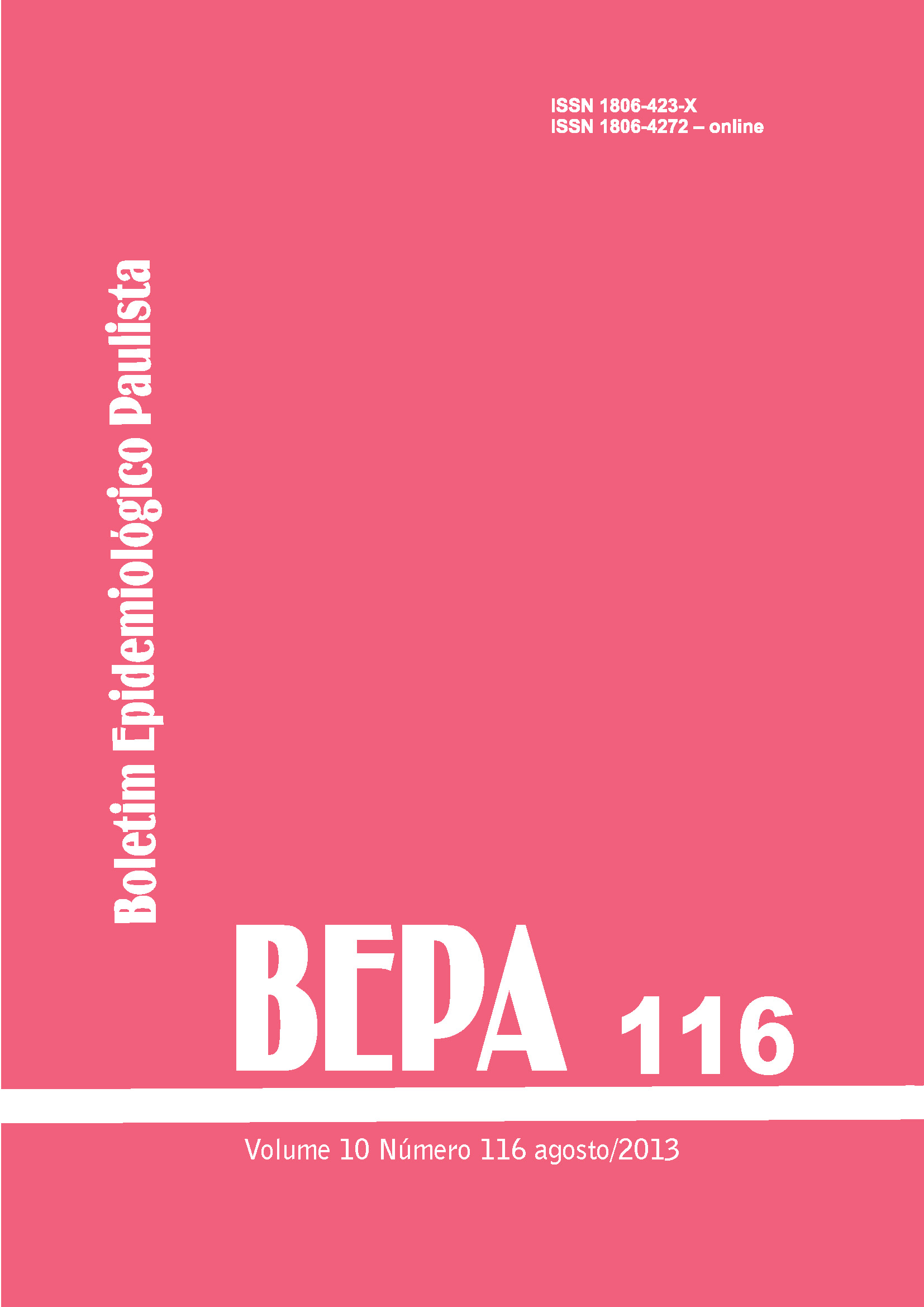Abstract
The Nutrition Surveillance System (SISVAN), created and implanted by the General Nutrition Coordination (CGAN/MS), according to the guidelines of the National Nutrition Policy (PNAN), allows the performance of diagnosis and follow up of the nutritional situation of the Brazilian population, contributing to the knowledge of the nature and the dimension of nutritional problems, and contributes, as well, for the identification of the geographical areas, social segments and population groups in higher risk for nutritional hazards. This study is designed to verify the nutritional status of the clientele registered in Basic Health Unities, per Regional Health Department (DRS) of the State of São Paulo, employing the SISVAN. The survey comprises data from 2010, and the number of registers in relation to the total of the population, for that year, was 3%. The DRS of the State of São Paulo with the higher number of registered people was DRS12 – Registro, and the one with the lowest number was DRS1- Metropolitan Region of Greater São Paulo. The proportion of seriously underweight children varied in circa 1%, nevertheless the amount of children with higher weight varied, in percentage, around 6,7 and 10,1% with an average of 8,7% (DP +1,9). From the total of registered adolescents, in average, 2,8% presented thinness/pronounced thinness; 72,9% were euthropic, but the percentage of overweight adolescents reached 24,3%. Among the adults registered at the SISVAN, 3,2% were underweight, 39,8% were euthropic and 57% were overweight; among the latter,, 31,3% were overweight and 26,1% (DP +1,63) were obese. Among the elderly, only 34,2% were euthropic, 10,9% were underweight and 55,9% (DP +4,80) were overweight. Despite the low rates of register at SIVAN, these results comply to other Brazilian studies, showing a concerning situation regarding nutritional status: the high proportion of overweight people in all age brackets. The SIVAN is an important tool to subsidize the strategies designed for promotion and prevention in health in the different managerial levels. A better use of this tool will support the resolution of actions designed to avoid the worsening of morbid situations that will demand more complex actions.
References
Brasil. Ministério da Saúde, Secretaria de Atenção à Saúde, Departamento de Atenção Básica. Política Nacional de Alimentação e Nutrição. Brasília; 2012 [acesso em: 4 maio 2013]. Disponível em: http://189.28.128.100/ nutricao/docs/geral/pnan2011.pdf
Brasil. Lei n. 8080, de 19 de setembro de 1990. Dispõe sobre as condições para a promoção, proteção e recuperação da saúde, a organização e o funcionamento dos serviços correspondentes e dá outras providências. Diário Oficial da União. 20 set 1990; Seção 1:018055.
Castro IRR. Vigilância alimentar e nutricional: limitações e interfaces com a rede de saúde. Rio de Janeiro: Fiocruz; 1995.
Brito P. Vigilância do estado nutricional de adultos: possibilidades e limitações. Rio de Janeiro: Universidade Federal do Rio de Janeiro; 2004.
Brasil. Ministério da Saúde, Secretaria de Atenção à Saúde. Vigilância alimentar e nutricional – SISVAN: orientações básicas para a coleta, processamento, análise de dados e informação em serviços de saúde. Brasília(DF); 2008.
Brasil. Ministério da Saúde, Secretaria de Atenção à Saúde. Protocolos do Sistema de Vigilância Alimentar e Nutricional - SISVAN na assistência à saúde. Brasília (DF); 2008 [3 setembro 2013]. Disponível em: http://189.28.128.100/nutricao/docs/geral/ protocolo_SISVAN.pdf
Brasil. Ministério da Saúde, Secretaria de Atenção à Saúde, Departamento de Atenção Básica. Política Nacional de Atenção Básica. Brasília(DF); 2006. (Série A. Normas e Manuais Técnicos. Série Pactos pela Saúde, v. 4).
Brasil. Conselho Nacional de Segurança Alimentar e Nutricional. Por um desenvolvimento sustentável com soberania e segurança alimentar e nutricional – Relatório final. In: II Conferência Nacional de Segurança Alimentar e Nutricional. Fortaleza; 2007. p. 49-52.
Monteiro CA, Conde WL. Tendência secular da desnutrição e da obesidade na infância na cidade de São Paulo (1947-1996). Rev Saúde Pública, 2000;34(6 Supl):52-61.
Batista Filho M, Rissin A. A transição nutricional no Brasil: tendências regionais e temporais. Cad. saúde pública. 2003:19(1):S181-S191.
Barreto SM, Pinheiro ARO, Sichieri R, Monteiro CA, Batista Filho M, Schimidt MI et al. Análise da estratégia global para alimentação, atividade física e saúde, da Organização Mundial da Saúde. Epidemiol. serv. saúde [periódico da internet]. 2005 [acesso em: 2 abr 2012]; 14(1): 41-68. Disponível em: http://portal.saude.gov.br/portal/arquivos/ pdf/4artigo_analise_global.pdf
Monteiro CA, Mondini L, Medeiros de Souza AL, Popkin BM. The nutrition transition in Brazil. Eur J Cl Nutr. 1995;49:105-13.
Popkin BM. The nutrition transition and its health implications in lower income countries. Public health nutr.1998;1:5-21.
Brasil. Ministério da Saúde, Secretaria de Vigilância em Saúde. VIGITEL Brasil 2011. Vigilância de fatores de risco e proteção para doenças crônicas por inquérito telefônico. Brasília(DF);2012.
Brasil. Ministério da Saúde, Secretaria de Vigilância em Saúde. Plano de ações estratégicas para enfrentamento das doenças crônicas não transmissíveis (DCNT) no Brasil 2011-2022. Brasília(DF);2011.
Lang RMF, Nascimento NA, Taddei JAAC. A transição nutricional e a população infanto-juvenil: medidas de proteção contra o marketing de alimentos e bebidas prejudiciais à saúde. Nutrire. 2009:34(3):217-29.
Brasil. Ministério da Saúde, Secretaria de Atenção à Saúde, Departamento de Atenção Básica. Relatório de Gestão 2007-2010 - Coordenação Geral de Alimentação e Nutrição. [monografia na internet]. Brasília (DF); 2011 [acesso em 12 jun 2012]. Disponível em: http://189.28.128.100/nutricao/docs/geral/ relatorioGestao2010.pdf

This work is licensed under a Creative Commons Attribution 4.0 International License.
Copyright (c) 2016 Africa Isabel de la Cruz Perez, Thiago Zillesg de Oliveira, Marco Antonio de Moraes, Mirian Matsura ShirassuMs , Adriana Bouças Ribeiro, Sonia Coria
